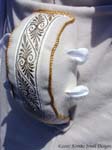 |
 |
 |
 |
 |
 |
 |
 |
 |
 |
 |
 |
 |
 |
This incredible Henrician ensemble was created for a client to wear while attending Southern California's Renaissance Pleasure Faire, as a customer not an actor. I was privileged to be asked to create this wonderful showpiece, coincidentally timed right after I had spent a few months in deep research for this exact time period (1520-1544 Henrician) on behalf of a well known pattern designer. Working on this ensemble allowed me to take the theory of what I had researched, and put much of it into practice. The client was also kind enough to allow me to try out a few new methods of construction on his garment.
The ensemble consisted of the following:
- A white linen shirt, with a high neck collar with a small pleated ruffle, and sleeve cuffs also with a pleated ruffle.
- A blue cotton velvet doublet with matching sleeves. The doublet and sleeves have small decorative cuts in a style known as "slash & puff", which is exactly what is done. Small cuts are made in the fabric, and small puffs of underlying white linen is pulled through to create a decorative effect. The doublet is further embellished with cream and gold trim edged with gold cord, and set off with fine gold-plated reproduction jewels imported from England's Steve Millingham Pewter Replicas (http://www.pewterreplicas.com).
- Fine wool flannel breeches, custom draped to fit the client's body very closely. The fabric is cut on the bias, and the upper portion is lined in linen. The most noticeable portion of the breeches is the decorative stuffed cod piece, embellished with "slash & puff", gold and cream trim, and gold cord, which can be seen boldly thrust out from between the jacket skirt opening. While a codpiece serves to cover the front opening of the breeches, the large cod piece was commonly worn by men during the Henrician period as a symbol of their virility. The design of the breeches was that most commonly worn during this period, and was deliberately kept simple, since most of it would not be seen much under the rest of the ensemble.
- Blue velvet jacket with an attached full skirt. This is another common garment for Henrician men to wear. This one has been cut in a U shaped front to show off the fine doublet worn underneath. The full skirt has rolled pleats (chosen to mimic the full pleat look of the time) which is hand sewn to the bottom of the jacket body. The gold and cream trim, edged with gold cord is placed to emphasize each pleat. A white silk sash tops off the jacket.
- A black velvet Henrician hat, jeweled the same as the doublet, and topped with several white ostrich feathers, completes the ensemble.
The client chose not to have the fur lined gown as seen in the images of Henry VIII.
en·sem·ble [ahn-sahm-buhl,
-sahmb; Fr. ahn-sahn-bluh]
1. all the parts of a thing taken together, so that each part is considered
only in relation to the whole.
2. the entire costume of an individual, esp. when all the parts are in
harmony.
c.1440, from M.Fr. ensemblee "all the parts of a thing considered
together," from L.L. insimul "at the same time," from in-
intensive prefix + simul "at the same time."
Home
Creative Blog
Kimiko Small Designs
Joan Silvertoppe's SCA Resumé
Warderobe Accounts
Brodyworke Accounts
Scriptor Arts Folium
Tudor Research
Workshops & Articles
Inspiration Gallery
Largesse
Favorite Links
About Me
Contact Me
http://www.kimiko1.com
Entire website, graphics, and text (unless otherwise stated)
© 2003-2013 Kimiko Small, All Rights Reserved


